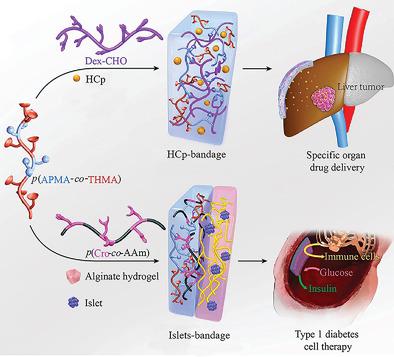当前位置:
X-MOL 学术
›
Adv. Mater.
›
论文详情
Our official English website, www.x-mol.net, welcomes your feedback! (Note: you will need to create a separate account there.)
An Adhesive Hydrogel with "Load-Sharing" Effect as Tissue Bandages for Drug and Cell Delivery.
Advanced Materials ( IF 29.4 ) Pub Date : 2020-09-18 , DOI: 10.1002/adma.202001628 Jing Chen 1 , Dong Wang 1 , Long-Hai Wang 1 , Wanjun Liu 1 , Alan Chiu 1 , Kaavian Shariati 1 , Qingsheng Liu 1 , Xi Wang 1 , Zhe Zhong 1 , James Webb 1 , Robert E Schwartz 2 , Nikolaos Bouklas 3 , Minglin Ma 1
Advanced Materials ( IF 29.4 ) Pub Date : 2020-09-18 , DOI: 10.1002/adma.202001628 Jing Chen 1 , Dong Wang 1 , Long-Hai Wang 1 , Wanjun Liu 1 , Alan Chiu 1 , Kaavian Shariati 1 , Qingsheng Liu 1 , Xi Wang 1 , Zhe Zhong 1 , James Webb 1 , Robert E Schwartz 2 , Nikolaos Bouklas 3 , Minglin Ma 1
Affiliation

|
Hydrogels with adhesive properties have potential for numerous biomedical applications. Here, the design of a novel, intrinsically adhesive hydrogel and its use in developing internal therapeutic bandages is reported. The design involves incorporation of “triple hydrogen bonding clusters” (THBCs) as side groups into the hydrogel matrix. The THBC through a unique “load sharing” effect and an increase in bond density results in strong adhesions of the hydrogel to a range of surfaces, including glass, plastic, wood, poly(tetrafluoroethylene) (PTFE), stainless steel, and biological tissues, even without any chemical reaction. Using the adhesive hydrogel, tissue‐adhesive bandages are developed for either targeted and sustained release of chemotherapeutic nanodrug for liver cancer treatment, or anchored delivery of pancreatic islets for a potential type 1 diabetes (T1D) cell replacement therapy. Stable adhesion of the bandage inside the body enables almost complete tumor suppression in an orthotopic liver cancer mouse model and ≈1 month diabetes correction in chemically induced diabetic mice.
中文翻译:

一种具有“负载共享”效应的粘性水凝胶,用作药物和细胞递送的组织绷带。
具有粘合特性的水凝胶具有许多生物医学应用的潜力。在这里,报告了一种新颖的、固有粘性水凝胶的设计及其在开发内部治疗绷带中的用途。该设计涉及将“三氢键簇”(THBC)作为侧基加入水凝胶基质中。THBC 通过独特的“负载共享”效应和增加的键密度导致水凝胶与一系列表面的强力粘附,包括玻璃、塑料、木材、聚四氟乙烯 (PTFE)、不锈钢和生物组织,即使没有任何化学反应。使用粘性水凝胶,组织粘性绷带被开发用于靶向和持续释放用于肝癌治疗的化疗纳米药物,或锚定递送胰岛用于潜在的 1 型糖尿病 (T1D) 细胞替代疗法。绷带在体内的稳定粘附能够在原位肝癌小鼠模型中实现几乎完全的肿瘤抑制,并在化学诱导的糖尿病小鼠中实现约 1 个月的糖尿病矫正。
更新日期:2020-10-26
中文翻译:

一种具有“负载共享”效应的粘性水凝胶,用作药物和细胞递送的组织绷带。
具有粘合特性的水凝胶具有许多生物医学应用的潜力。在这里,报告了一种新颖的、固有粘性水凝胶的设计及其在开发内部治疗绷带中的用途。该设计涉及将“三氢键簇”(THBC)作为侧基加入水凝胶基质中。THBC 通过独特的“负载共享”效应和增加的键密度导致水凝胶与一系列表面的强力粘附,包括玻璃、塑料、木材、聚四氟乙烯 (PTFE)、不锈钢和生物组织,即使没有任何化学反应。使用粘性水凝胶,组织粘性绷带被开发用于靶向和持续释放用于肝癌治疗的化疗纳米药物,或锚定递送胰岛用于潜在的 1 型糖尿病 (T1D) 细胞替代疗法。绷带在体内的稳定粘附能够在原位肝癌小鼠模型中实现几乎完全的肿瘤抑制,并在化学诱导的糖尿病小鼠中实现约 1 个月的糖尿病矫正。


























 京公网安备 11010802027423号
京公网安备 11010802027423号